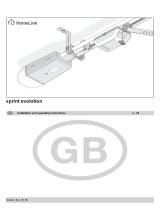Page is loading ...

1
XRF-TW
4.4
4.4
51
43
15
9
9
58
17
1666
< 5 mm
3 V
LITHIUM
CR2450N
+
LED
39
8
Transmitter for wicket doors to XRF wireless transmission system
Original operating instructions
Intended use: Monitoring wicket doors on industrial doors, in combination with a receiver XRF
Saftey instructions
ENGLISH
404302E
01/22
Transmitter (Tx)
1.1 Industrial door with wicket door
Transmitter for wicket door monitoring to stop the door moving when the wicket door is open.
Push button
Magnets
Battery
CR2450N
Receiver
Transmitter
Magnet
Wicket door
1Common application
2Mounting and set-up
Mount
transmitter and
magnet
Note: Distance
between magnet /
transmitter when
door is closed
Wicket
door
correctly
positioned
possibly add
underlay
• Read these operating instructions thoroughly before putting the device into
operation and keep them for future reference.
• Donotusethisproductotherthanforitsspeciedapplication.
• Onlytrainedandqualiedpersonnelmayinstallandinitializethedevice.
• Onlyauthorizedfactorypersonnelmayperformhardware/softwarechangesor
repairs to the product.
• Failure to follow these safety precautions may cause damage to sensor or objects,
serious personal injury, or death.
• It is the responsibility of the equipment manufacturer to carry out a risk assess-
ment and to install the system, in compliance with applicable local, national and
international regulations, safety standards, codes and laws as well as the
Machinery Directive 2006/42/EC, should this apply.
• Always consider the safety functions of your applications as a whole, never just in
relation to one individual section of the system.
• The installer is responsible for testing the system to ensure it meets all applicable
safety standards.
• SafetydevicesthatareclassiedasCategory2accordingtoENISO13849-1must
be tested regularly – at least once per cycle.
• If the safety device is not requested operationally at least once a year, it must be
checked manually by the operator at least once a year.
• Pay attention to all local relevant electrical safety regulations.
• Protect the device with a housing against contamination or aggressive environ-
ments.
• This device contains batteries.
• Observe the local regulations for battery disposal.
• After accessing the inside of the sensor, ensure the cover/protection seal is
closed tightly to achieve designated protection rating.

2
OK?
DesignedinSwitzerland/MadeinChina
BBC Bircher Smart Access, BBC Bircher AG, Wiesengasse 20, CH-8222 Beringen, www.bircher.com
2x
OK?
OK?
3x
i
Open housing by pulling on cover
Remove battery
Insert new battery
Close the cover
Dispose battery according to local regulations
4Trouble shooting
4.1 Warning indicator for low battery voltage
4.2 Battery change
5Technical data
6EU Declaration of Conformity
8Contact
See attachment
System
Operating frequency 868.3MHz
Range 60 m (at optimal condition)
Operating temperature –20 °C to +60 °C
Transmitter
Input Magnetic switch
Battery power 1x Lithium 3 V (CR2450N)
Battery life up to 1.2 years *)
Protection class IEC 60529 IP65
7WEEE
Devices with this symbol must be treated separately during disposal. This must be done in accordance with the laws of
the respective countries for environmentally sound disposal, processing and recycling of electrical and electronic equipment.
Tondoutwhichtransmitterhaslow
battery voltage: Press each edge and
open / close the wicket door.
Every minute Battery good Battery bad
Beep
After initiating pairing on Rx:
Press button
Check the function
by opening the wicket door
3.1.b Pairing when mounted
After initating pairing on Rx:
By opening the door two times
within 2 sec.
3Pairing
3.1.a Pairing with open cover
Pairing is possible with open cover or later when already mounted.
3.2 Functional check
*) Recommendation: Change battery every year.
Beep
Flashes
red
Flashes
red
Does the door stop when wicket door is opened?
UsetypeCR2450NbecauseCR2450doesnott!
Further details see manual of receiver
/

